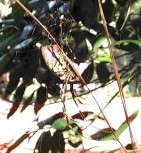Chances are, if you live in northeast Georgia you’ve come across an East Asian Joro spider this fall. At almost 3 inches across when their legs are fully extended, they’re hard to miss. While they’re roughly the same size as orb spiders, the distinctive yellow and blue-black stripes on their backs and bright red markings on their undersides are unique. Their enormous three-dimensional webs are a striking golden color and tend to be located higher off the ground than those of other spiders. “We’ve been getting lots of calls and emails from people reporting sightings,” said Byron Freeman, director of the Georgia Museum of Natural History. “They seem to be really common in riparian areas and in urban areas around people’s houses, but they’re also in the deep woods.”
Joro spiders have spread widely since they were first spotted in Hoschton, Georgia, in 2013. They probably arrived by hitching a ride in a shipping container from China or Japan. Joro spiders appear to have successfully established themselves in the area, with recent confirmed reports from as far afield as Blairsville, Georgia, and Greenville, South Carolina. But there is still much that remains unknown about them. One important question is how they might affect the local ecosystem. Will they out-compete other orb weaving spiders? Will they reduce insect populations through predation? “We don’t know what the impact is going to be…right now, we’re trying to learn as much as we can about them.”
So far, early observations indicate that Joros are coexisting with the area’s other orb weaving spiders, with webs close to, and in some cases even attached to, one another. And Joro spiders also appear to be able to capture and feed on at least one insect that other local spiders are not: adult brown marmorated stink bugs, an invasive pest that can infest houses and damage crops. In turn, Joro spiders are vulnerable to predators like mud dauber wasps and birds.
Here’s what we do know: Joro spiders travel by ballooning, letting the wind carry them on a strand of gossamer. “The male has to drift in and find the female,” Freeman said. “Sometimes there’ll be four or five males on a web, sometimes there’ll be one, so the males are moving between webs. When you have a large population it seems feasible that a male could just drift from one spot to the next.”
Despite their size, Freeman said that Joro spiders don’t pose a threat to people. “All spiders have venom that they use to subdue prey,” he said. “If you put your hand in front of one and try to make it bite you, it probably will. But they run if you disturb their web. They’re trying to get out of the way. “Freeman said that Joros can be shooed away with a broom if they’re in a location that puts them too close for comfort. But as for removing them permanently, he compared such efforts to shoveling sand at the beach. “Should you try to get rid of them?” said Freeman. “You can, but at this point, they’re here to stay. If you spot a Joro spider—especially if you can provide a photo tagged with date and location—please contact Hoebeke at [email protected].
In the August 25 edition of the North Fulton Revue and News, editorialist Steve Hudson wrote about discovering one in his yard and doing his own research on it. He found out that the name Joro was given to this spider because in Japanese mythology a Jorogumo is a shape-shifting spider that can take on the form of a beautiful woman who tempts men into her grasp and then binds them with strong silk before devouring them.
Opinions on this sudden onslaught of these spiders and webs differs. While Hudson is ‘spellbound’ by the vivid colors and strong, sticky webs, bug expert Hal Coleman had a different opinion. When I contacted him via Facebook for his opinion, he stated , “Joro is a nuisance in my yard already.”
In his September 23 Atlanta Journal-Constitution garden column Joro spiders here to stay in Georgia, Walter Reeves writes “the spiders have now been spotted in at least 23 counties, as far west as Alpharetta and north to Rabun and Union counties. So far, they have been reported nowhere else in North America”.
Welcome to Georgia, Joro!

